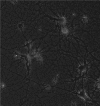The Influence of Vitamin D Treatment on the Inducible Nitric Oxide Synthase (INOS) Expression in Primary Hippocampal Neurons
- PMID: 28360617
- PMCID: PMC5353092
- DOI: 10.4274/npa.y7089
The Influence of Vitamin D Treatment on the Inducible Nitric Oxide Synthase (INOS) Expression in Primary Hippocampal Neurons
Abstract
Introduction: Neurodegeneration is a process that is characterized by the loss of neuronal structure and function and eventually ends with neuronal death. An elevated level of inducible nitric oxide synthase (iNOS) is suggested to accompany this process by inducing oxidative and nitrosative damage. Vitamin D is reported to protect glial cells against neurotoxicity via suppressing iNOS synthesis. Though there was no data about whether iNOS is regulated by vitamin D in hippocampal neurons. In this study our aim was to determine any alteration in iNOS expression of hippocampal neurons in response to vitamin D treatment.
Method: Twenty four and 48 hours of vitamin D treatments were performed on primary hippocampal neuron cultures that were prepared from Sprague dawley rat embryos (E18). The alterations in the iNOS mRNA expression were determined with quantative real time polymerase chain reaction (qRT-PCR). The cytotoxicity levels of each group were investigated by the measurement of lactate dehydrogenase (LDH) that is released to culture medium.
Results: No difference was observed between groups in 24 hours of treatment regarding the iNOS expression. Though the iNOS mRNA level of vitamin D treated group was significantly lower than that of control group on the 48th hours of treatment (p<.001). Vitamin D treatment also attenuated the LDH release which is an indicator of cytotoxicity (p<.001).
Conclusion: Our results indicated that vitamin D has the potential to prevent oxidative damage by suppressing iNOS expression.
Amaç: Nörodejenerasyon, sinir hücrelerinin yapı ve fonksiyonlarını kaybetmesine bağlı olarak nöron ölümü ile sonuçlanan bir süreçtir. Bu süreçte artan indüklenebilir nitrik oksit sentaz (iNOS) seviyelerinin, hücrelerin oksidatif ve nitrozatif hasarına sebep olarak nörodejenerasyona eşlik ettiği düşünülmektedir. Vitamin D’nin ise glia hücrelerinde iNOS sentezini baskılayarak hücreleri nörotoksisiteye karşı koruduğu ileri sürülmektedir. Ancak iNOS’un hippokampal nöronlarda vitamin D tarafından düzenlenip düzenlenmediğini gösteren herhangi bir çalışma yoktur. Bu çalışmadaki amacımız, hippokampal nöronların vitamin D uygulamasına cevap olarak iNOS anlatımlarında bir değişiklik olup olmadığını belirlemektir.
Yöntem: Sprague dawley cinsi sıçanların 18 günlük embriyolarının hippokampuslarından hazırlanan primer nöron kültürlerine 24 ve 48 saat süre ile vitamin D uygulandı. iNOS mRNA miktarlarındaki değişimler kantitatif gerçek zamanlı polimeraz zincir reaksiyonu (qRT-PCR) yöntemi ile belirlendi. Tüm grupların sitotoksisite seviyeleri kültür medyumuna salınan laktat dehidrogenazın (LDH) ölçülmesi ile belirlendi.
Bulgular: Yirmi dört saat boyunca vitamin D uygulanan grupla diğer gruplar arasında herhangi bir iNOS anlatımı açısından bir fark gözlenmezken, 48 saat süreyle vitamin D uygulanan hippokampal nöronların iNOS mRNA seviyelerinin kontrol gruplarına kıyasla anlamlı derecede düştüğü saptandı (p<0,001). Ayrıca, vitamin D uygulamasının sitotoksiste belirteci olan LDH salınımını da azalttığı saptandı (p<0,001).
Sonuç: Sonuçlarımız, vitamin D’nin iNOS anlatımındaki artışı engelleyerek, hippokampal nöronları oksidatif hasara karşı koruyabileceğini göstermektedir.
Keywords: Alzheimer’s disease; inducible nitric oxide synthase (iNOS); primary hippocampal neuron culture; vitamin D.
Conflict of interest statement
Conflict of Interest: The authors reported no conflict of interest related to this article. Çıkar Çatışması: Yazarlar bu makale ile ilgili olarak herhangi bir çıkar çatışması bildirmemişlerdir.
Figures



Similar articles
-
The Effect of Vitamin D Treatment On Nerve Growth Factor (NGF) Release From Hippocampal Neurons.Noro Psikiyatr Ars. 2014 Jun;51(2):157-162. doi: 10.4274/npa.y7076. Epub 2014 Jun 1. Noro Psikiyatr Ars. 2014. PMID: 28360616 Free PMC article.
-
A new mechanism for amyloid-β induction of iNOS: vitamin D-VDR pathway disruption.J Alzheimers Dis. 2013;36(3):459-74. doi: 10.3233/JAD-130416. J Alzheimers Dis. 2013. PMID: 23624519
-
Minocycline inhibits apoptotic cell death via attenuation of TNF-alpha expression following iNOS/NO induction by lipopolysaccharide in neuron/glia co-cultures.J Neurochem. 2004 Nov;91(3):568-78. doi: 10.1111/j.1471-4159.2004.02780.x. J Neurochem. 2004. PMID: 15485488
-
Expression of the inducible nitric oxide synthase in distinct cellular types after traumatic brain injury: an in situ hybridization and immunocytochemical study.Acta Neuropathol. 2000 Aug;100(2):196-204. doi: 10.1007/s004019900167. Acta Neuropathol. 2000. PMID: 10963368
-
The nitric oxide hypothesis of aging.Exp Gerontol. 1998 Nov-Dec;33(7-8):813-26. doi: 10.1016/s0531-5565(98)00050-3. Exp Gerontol. 1998. PMID: 9951625 Review.
Cited by
-
Effects of probiotic and vitamin D co-supplementation on migraine index, quality of life, and oxidative stress in adults with migraine headache: a randomized triple-blinded clinical trial.Eur J Nutr. 2025 May 13;64(4):179. doi: 10.1007/s00394-025-03687-w. Eur J Nutr. 2025. PMID: 40360751 Clinical Trial.
-
Association of vitamin D receptor gene TaqI polymorphism with Alzheimer's disease in a Southeastern European Caucasian population.Exp Ther Med. 2022 May;23(5):341. doi: 10.3892/etm.2022.11271. Epub 2022 Mar 22. Exp Ther Med. 2022. PMID: 35401802 Free PMC article.
-
Association between serum vitamin D levels and age in patients with epilepsy: a retrospective study from an epilepsy center in Saudi Arabia.Ann Saudi Med. 2022 Jul-Aug;42(4):262-268. doi: 10.5144/0256-4947.2022.262. Epub 2022 Aug 4. Ann Saudi Med. 2022. PMID: 35933609 Free PMC article.
-
Vitamin D in migraine headache: a comprehensive review on literature.Neurol Sci. 2019 Dec;40(12):2459-2477. doi: 10.1007/s10072-019-04021-z. Epub 2019 Aug 3. Neurol Sci. 2019. PMID: 31377873
-
Nitrosative Stress in the Frontal Cortex From Dogs With Canine Cognitive Dysfunction.Front Vet Sci. 2020 Nov 19;7:573155. doi: 10.3389/fvets.2020.573155. eCollection 2020. Front Vet Sci. 2020. PMID: 33330694 Free PMC article.
References
-
- Squire L. Memory and the hippocampus: a synthesis from findings with rats, monkeys, and humans. Psychol Rev. 1992:195–231. - PubMed
-
- Hardy J. Amyloid, the presenilins and Alzheimer’s disease. Trends Neurosci. 1997;20:154–159. - PubMed
-
- Hardy J, Selkoe DJ. The amyloid hypothesis of Alzheimer’s disease: Progress and problems on the road to therapeutics. Science. 2002;297:353–356. - PubMed
LinkOut - more resources
Full Text Sources
Other Literature Sources
